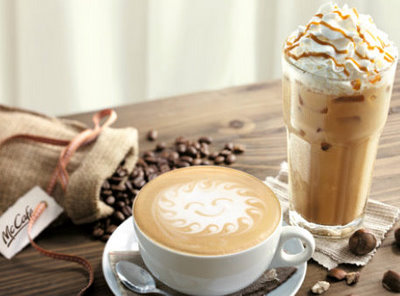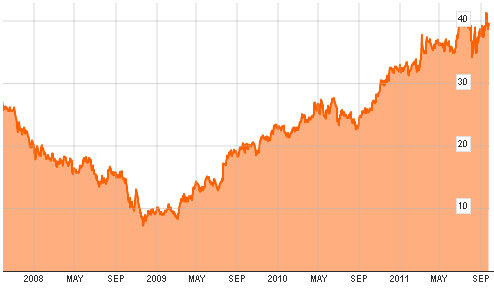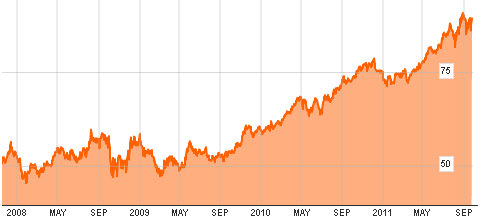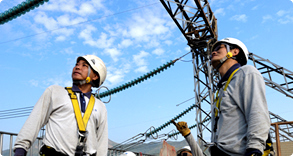
Translated by Andrew Vanburen from: 一個講金 一個講心 餐廳孖寶成功之謎 (中文翻譯, 請閱讀下面)
IT SEEMS that no market has been free from freefall selloffs of late, with budget crises, sovereign debts and political turmoil turning investor sentiment decidedly downtrodden.
However, even as consumer sentiment struggles to recover, two major names in the restaurant business have proven to be brazenly countercyclical, and may point to similar opportunities in Hong Kong.
In fact I would put forth that during bear markets, the most interesting case studies are the stocks which actually climb up the valuation chain. This is not only because they buck the trends, but also because they must enjoy a level of intrinsic value that warrants closer investigation.
Looking overseas, two of the best examples of this phenomenon are fast food giant McDonald’s and cyber/casual chat/caffeine filling station leader Starbucks.
Year-to-date, McDonald’s has provided a return on investment of around 17% while Seattle-based Starbucks is even better at 23%.
These compare very favorably indeed to the weighted ROI for the S&P 500 which over the same period is at negative 2%.

Some may point to the near monopoly-like presence of these two food and beverage (F&B) behemoths, and the absence of US antitrust legislation covering the sector, as reasons for their success.
But at the end of the day, no one forces consumers – American or otherwise – to stand at the counter waiting for Big Macs or iced lattes.
Therefore, comparing them to something more familiar to local investors such as Hong Kong power firm CLP Holdings Ltd (HK: 2) -- whose shares are currently near 52-week highs with a one-year return of over 22% -- is a flawed argument.
Furthermore, if investors are hoping to find facile parallels between McDonald’s and Starbucks and the secrets to their recent valuation strength, they will be sorely disappointed because the two cases are very unique.
As for McDonald’s, the current helmsman – CEO Jim Skinner – never graduated college but served 10 years in the US Navy. Therefore, at the risk of resorting to clichés, he runs a tight ship and like most Navy veterans, doesn’t believe small talk and gossip have any place on a crowded vessel... or in a Fortune 500 company.

He keeps his cards close to his chest and only shares pertinent company information with those at the top, and on a need-to-know basis only.
Prior to Skinner taking charge in November 2004, McDonald’s Corporation was struggling to stay on top, with consistently falling profits for the Illinois-based firm.
He quickly determined that the home of the Golden Arches was failing to compete with the growing number of rivals in the fast food space and was instead over-relying on its well-worn strategies and menu offerings of yesteryear.
He also felt that the company was moving away from its core business strengths and diversifying into unchartered waters for a global restaurant chain (according to Fortune, McDonald’s previously owned and operated luxury Swiss hotels).
However, after streamlining operations and refocusing on its core strengths, post-Skinner McDonald’s set one goal for the restaurant chain.

Whether proprietary or locally-managed and licensed, each restaurant would be solely devoted to boosting revenue, and success was to be measured by this standard alone.
Thanks in large part to Skinner’s leadership, McDonald’s group revenue rose to over 70 bln usd in 2008 from around 50 bln in 2004.
In 2009, he was named CEO of the Year by Chief Executive magazine.
100 consecutive months of growth
McDonald’s used its newly restructured business model, reemphasized accountability, digitalized logistics and ordering systemization to know exactly how many French fries and hamburger patties each restaurant should have in stock on any given day.
The fast food chain recently said its August same-store sales (SSS) growth rose 3.5% year-on-year.
On the surface this announcement seems quite par for the industry, but its largest market is still struggling to avoid double-digit unemployment, and August’s SSS rise was the 100th consecutive monthly increase, setting a new company record!
With numbers like these, it is little wonder the 90 bln usd franchise is attracting such investor attention.
Starbuck’s rise has followed a very different path to prominence.

CEO Howard Schultz is far more interested in the connection between interpersonal and societal relationships to a successful business than is McDonald’s Skinner because, quite frankly, sipping coffee is by nature much more social an activity than ordering a Big Mac through a drive-thru window.
Schultz is also more appreciative of the marriage-of-convenience that exists between an increasingly technical world and the whole cafe experience.
He is most interested in providing a comfortable quasi-corporate setting for patrons and providing the best beans available than in maximizing same-store sales for revenue’s sake alone, because it is the setting and ambience as well as the purchased product, that has brought the Seattle-based firm this far.
Therefore, he is known as a stickler for quality – both in terms of goods and services – and is known as one of the biggest advocates of staff training, followed by regular refresher courses.
Therefore, most employees would admit that getting a job at Starbucks is much harder than at McDonald’s.

Schultz not only insists on the high quality beans for Starbuck’s roasted blends, but also the highest quality staff available, which makes sense if one thinks of how long one normally spends lounging in a Starbuck’s venue surrounded by Baristas compared to the typical quick, utilitarian visit to a fast food restaurant.
Intangibles like the “added value” of comfortable seating and smiling serving staff also allow Starbucks to have more flexibility in pricing as compared to more volume-centric McDonald’s.
The two F&B giants have different business models, but the results are the same – enviable returns for shareholders.
Therefore, for market watchers like myself, it is important not to fall into the lazy habit of saying successful industry peers must have similar growth models.
Those who like the beauty and strength of raw numbers will likely be more comfortable investing in McDonald’s shares.
However, for those of us who appreciate a good “overnight” success story with staying power, perhaps Starbucks is a better choice.
And finally, for those of us with a soft side for the Hong Kong market, there are certainly more than a few proxies for these two examples worthy of investor attention.
See also:
Restaurant Giant SHANGHAI MIN’S IPO; Latest On PRC Property/Insurance
一個講金 一個講心 餐廳孖寶成功之謎
黃國英, 豐盛融資資產管理部董事

大跌時期,股價最堅挺者,可進一步研究。放眼海外,會發現麥當勞(MCD)、星巴克(SBUX)一對孖寶兄弟。
年初至截稿前,老麥總回報17%、星仔為23%;標普五百指數為負2%,兩股跑贏大市幾條街。沒有法定壟斷,食客不是老馮幫襯,回報竟達中電(0002)級數,殊非易事。但如打算整合兩者成功之道,卻會發現實在南轅北轍。
老麥似是陣容嚴整的軍團。舵手史堅拿(Skinner),海軍出身,以不講廢話、不搞個人形象聞名,相當潛藏。上任之前,公司連折兩總裁(一死一病危),臨危受命,其時生意表現低沉。沒有大展拳腳,反而結束積聚多年、無關主業的生意。(據「財富」報道,老麥竟一度在瑞士經營酒店。)公司精簡後,目標只餘一個:不論自營、特許店,都要增加每店收入。
連續一百個月增長
老麥由是建立重計劃、重問責的文化,行事數字化、系統化,一塊薯餅點先合格,一個餐要幾耐起貨,統統有法可依。執行上一絲不茍,也在營運數據上反映:早前公司公布,八月同店按年增長3.5%,驟眼看來,無甚特別,但細看才發現,原來已是連續一百個月,錄得升幅。九百億美金市值的公司,能有如此表現,故極受投資界歡迎。
星巴克則剛好相反。兩度掌舵的舒茲(Howard Schultz),首重人際關係,數字次之。醉心咖啡,銳意營造符合公司格調的店面,寧可減低收入,同店銷量數字下降,也不賣利潤高,但影響觀感的周邊商品。為求重整產品質素,不惜損失六球美金、股價飛插,毅然將全美國七千一百家門店,關門數小時,全體再培訓。舒茲尤其喜好陣前喊話,為員工打氣,亦不介意出面,提升企業形象,甚至出版了兩本著作,描寫自己與公司的經歷。雖然公司要求嚴格,但不失善待員工,廣發股票期權,以期上下一心。相比之下,麥記的McJob,英文字典都有記載,意為:低薪、無聊、冇景,當然不可同日而語。
長期溢價賣咖啡
對員工講感情、對顧客講感覺,面面俱圓的經營方式,在成本掛帥的飲食行業,似乎難以生存。偏偏其路線獨特,培養出一批講心不講金的粉絲,能長期以溢價出售咖啡,兼且將士用命,品質得以維持。公司盈利屢創新高,雖然在海嘯的兩年,純利倒退,但去年已再度破頂。
麥當勞、星巴克着眼點全然不同,但同樣得到很好的效果。所以分析股票時,不宜認定只有某一種經營方法,才可以取得成功,才算是好公司。喜歡拆解數據的人,會較賞識麥記類的公司;愛好企業奮鬥故事者,則傾向星巴克類。兩種方向,亦無高下之分。最重要的,是任何合理的策略,最終一定會帶來盈利、現金。如果成日都無錢返,則一切免談。而了解公司策略後,可細心觀察有無偏離軌道。當有日麥記月月倒退、星巴克任由舖面惡化,則兩股可以休矣。
請看: 宝峰:中国顶级拖鞋公司,上半年销售激增30%至近6亿元人民币



If Obama makes every corporate to use 10% of their net cash to buy 30-years US treasury bills, then the US debt problem would be solved tomorrow!